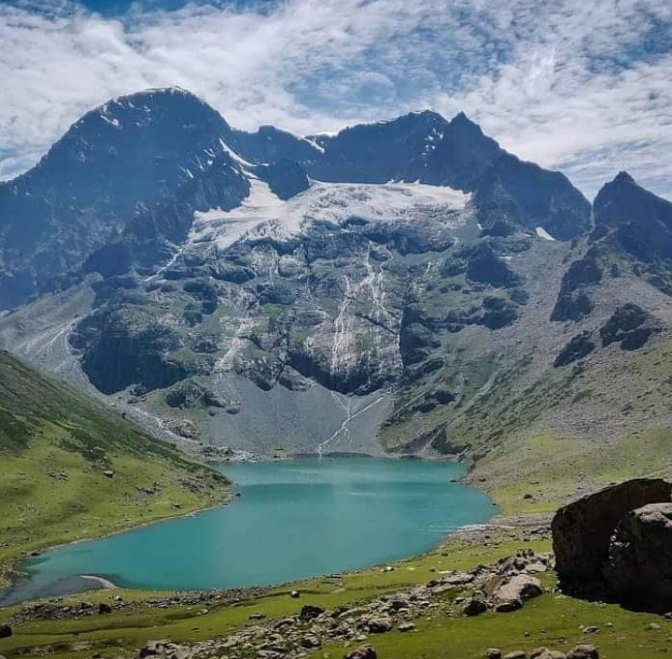Kashmir Great Lakes Trek
The Kashmir Great Lakes Trek , a journey that stands out for its unique features, is a trek that speaks for itself. Its name alone evokes images of breathtaking beauty and adventure. Nestled in the heart of the Himalayas, Kashmir is a haven for nature lovers and thrill-seekers alike. This trek offers a one-of-a-kind experience that will imprint unforgettable memories. The pristine lakes and snow-capped mountains are a sight to behold; their tranquillity and majesty will leave you in awe. The trek is an opportunity to immerse yourself in the natural beauty of Kashmir and create memories that will last a lifetime.
Kashmir, known as the earth’s paradise, is the location of this trek, which lasts around 7-9 days and is considered moderately challenging. The elevation reaches 13000 feet, and the distance covered is approximately 63 km. This trek provides an opportunity for self-discovery on multiple levels – physical, mental, and emotional. The experience of pushing one’s body to its limits and overcoming doubts about completing the trek is a challenge like no other. While the journey may be tough, the sense of accomplishment upon reaching the destination is unparalleled. This trek can be a happy and memorable experience for trekkers with proper preparation.
To embark on the challenging journey to the Kashmir Great Lakes Trek, it’s crucial to prioritize your health and well-being. Ensure you’re in top physical condition by engaging in regular gym sessions and incorporating activities like running, walking on an incline, cycling, cross-training, and stretching into your daily routine. Mental fitness is equally vital, so cultivate a positive mindset and practice stress-reducing techniques to help you cope with the demands of the trek. This preparation will not only make the trek more enjoyable but also increase your chances of successfully completing it.
Along the Srinagar road, the trek begins approximately 3 kilometres outside Sonamarg. You’ll encounter a few roadside restaurants and dhabas where you can grab snacks or light meals. It’s recommended that trekkers stop here to stock up on provisions, as the next opportunity for food and shelter won’t be until Naranag, which marks the end of the trail.
The path winds through a picturesque meadow with lush green grass, offering breathtaking views of the Sonamarg town below. As trekkers ascend, they reach the threshold of a dense forest, where towering Maple and Pine trees stand sentinel. The ensuing trail unfolds into a romantic paradise, with the dense canopy of Maple trees creating a dreamy, intimate atmosphere that is singular to this trek in India. This unique beauty of the trek is sure to intrigue and excite any adventure enthusiast.
The Kashmir Great Lakes Trek is a journey that speaks for itself. Its name alone conjures up images of breathtaking beauty and adventure. Located in the heart of the Himalayas, Kashmir is a paradise for nature lovers and thrill-seekers alike. This trek offers a once-in-a-lifetime experience that will leave you with unforgettable memories. The pristine lakes and snow-capped mountains are a sight; their tranquillity and majesty will leave you spellbound. The trek is a chance to immerse yourself in the natural beauty of Kashmir and create memories that will last a lifetime.
Kashmir, known as the earth’s paradise, is the location of this trek, which lasts around 7-9 days and is considered moderately challenging. The elevation reaches 13000 feet, and the distance covered is approximately 63 km. This trek provides an opportunity for self-discovery on multiple levels – physical, mental, and emotional. The experience of pushing one’s body to its limits and overcoming doubts about completing the trek is unmatched. While the journey may be challenging, the sense of accomplishment upon reaching the destination is unparalleled. This trek can be a happy and memorable experience for trekkers with proper preparation.
To embark on the challenging journey to the Kashmir Great Lakes Trek, it’s crucial to prioritize your health and well-being. Ensure you’re in top physical condition by engaging in regular gym sessions and incorporating activities like running, walking on an incline, cycling, cross-training, and stretching into your daily routine. Mental fitness is equally vital, so cultivate a positive mindset and practice stress-reducing techniques to help you cope with the demands of the trek.
Along the Srinagar road, the trek begins approximately 3 kilometres outside Sonamarg. You’ll encounter a few roadside restaurants and dhabas where you can grab snacks or light meals. It’s recommended that trekkers stop here to stock up on provisions, as the next opportunity for food and shelter won’t be until Naranag, which marks the end of the trail.
The path winds through a picturesque meadow with lush green grass, offering breathtaking views of the Sonamarg town below. As trekkers ascend, they reach the threshold of a dense forest, where towering Maple and Pine trees stand sentinel. The ensuing trail unfolds into a romantic paradise, with the dense canopy of Maple trees creating a dreamy, intimate atmosphere that is singular to this trek in India.


